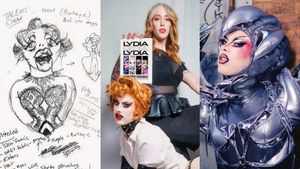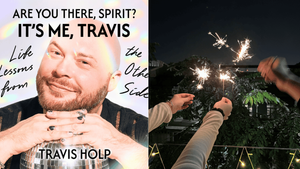Billy Hargrove is preening in front of a mirror, his muscled chest exposed through an unbuttoned shirt. The teen sprays product into his long, curly hair -- an earring dangles from his left ear -- and rubs cologne down his tight jeans into his crotch. He checks out his butt, leans in close to his reflection, blows out smoke, and winks.
Then his father walks in.
"You've been staring at yourself in the mirror like some f****t instead of watching your sister," his dad screams, before slamming him against a wall and striking his son. His wife tries to calm him and say, "It's OK." He replies, "Nothing about his behavior is OK."
Season 1 of Stranger Things was replete with instances where homophobia was used to humiliate and intimidate the Netflix show's protagonists, who are described at different points with antigay slurs like "perverts," "fairies," "queer," and "weirdo" by young bullies.
Stranger Things 2 has fewer such examples. But the scene between Billy and his father, described above, introduces the most graphic and significant instance of homophobia in the show yet. It is notable as the first time the show has used the f word. That this word is uttered by an adult parent, who couples it with violence, reestablishes antigay animus as one of the main (and apart from supernatural monsters, the most dangerous) conflicts of the new season.
As of yet, there are no out LGBT characters in the world of Stranger Things -- which might seem strange, considering homophobia's prevalence in the horror series. However, the show's mining of '80s nostalgia -- referencing films from that era like A Nightmare on Elm Street, E.T., and Gremlins -- also taps into an oeuvre and time in which queer characters were coded rather than overt. Its not an excuse for LGBT exclusion, but the rules here are different.
As first referenced in The Advocate's article "Homophobia Is the Real Monster in Stranger Things," all of the young protagonists are queer in some fashion, because they are outsiders who defy heteronormativity. Jonathan Byers (Charlie Heaton) is a loner and a photographer. Mike (Finn Wolfhard), Will (Noah Schnapp), Lucas (Caleb McLaughlin), and Dustin (Gaten Matarazzo) are harassed for their love of A.V. Club and fantasy games like Dungeons & Dragons. And Eleven (Millie Bobby Brown) is the clearest allegory of a queer character. A gender-nonconforming child with supernatural abilities, she escapes a government institution and endures homelessness before discovering a found family with these other young folks. Her journey has resonated with many LGBT viewers.
But Hargrove, who is a primary human villain this season, is also a queer character, albeit of a different variety. His appearance conjures several homoerotic archetypes -- the jock, the James Dean rebel, the Tom of Finland man, the California weightlifter. And queer fans have taken notice. News that the actor who portrays him, Dacre Montogomery, oiled his body and danced in a G-string for his audition tape went viral in gay media. His pinup image is even given a tongue-in-cheek reference in Stranger Things 2. In one scene, Karen Wheeler, Mike's mom, is bathing while reading a Johanna Lindsey romance novel with a muscle-bound man on the cover. The doorbell rings, and the fantasy comes to life when Hargrove is at the door. Is he real? Is he fantasy? Barbara Streisand's "The Way We Were" plays in the background.
Thus, that Hargrove should be a victim of homophobia on the part of his father is no surprise, given his appearance. Hargrove is a caricature of masculinity, but he is also subverting it by wearing jewelry, for example, and by his mirror-gazing vanity.
But there is also evidence in the series to suggest that the character might actually be gay or bisexual. Hargrove is allegedly preparing for a date when his father walks in, but the identity of the date is never revealed. Nancy Wheeler, the designated hot girl in Hawkins High, is "not my type," he later tells Nancy's mother, with whom he flirts in order to obtain information.
The real chemistry is yet to come. Afterward, Hargrove encounters Steve Harrington, last season's bully, who has since reformed to become an ally of the protagonists. "Am I dreaming, or is that you, Harrington?" Hargrove asks. "It's me, don't cream your pants," Harrington responds. The pair then engage in a bloody fistfight, which is also one of the most visceral and physical encounters of the season. "No one tells me what to do," Hargrove tells Harrington, who demanded that he leave. But of course, it was his father, using a slur and violence, who ordered him to be there in the first place.
This fight is a culmination of several scenes of borderline flirtation. Hargrove first seeks Harrington out at a Halloween party when he is drunk, soaked in beer, and shirtless -- bypassing a room full of women to find him. In other episodes, Hargrove physically engages with Harrington on the basketball court, where he is also shirtless. Afterward, he participates in a three-way shower scene with Harrington and another player, who teases Harrington for losing the attention of his girlfriend, Nancy. "Don't take it too hard man. A pretty boy like you has nothing to worry about," Hargrove assures Harrington with a playful smile.
In other words, Stranger Things 2 could have made Hargrove into a flat character without much background -- as it did with last season's jerks. But the choice to show him as a victim, in addition to a victimizer, complicates his motives. It shows that a bully can be made by bullying. Violence creates violence. Hate engenders hate. A character who might be gay may also weaponize homophobia. And before one fights the monsters of the Upside Down, one must first confront the human fears that also threaten to destroy us.
DANIEL REYNOLDS is an editor of The Advocate. Follow him on Twitter @dnlreynolds.




































































Charlie Kirk DID say stoning gay people was the 'perfect law' — and these other heinous quotes